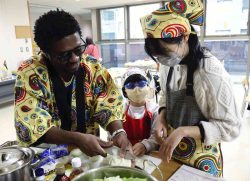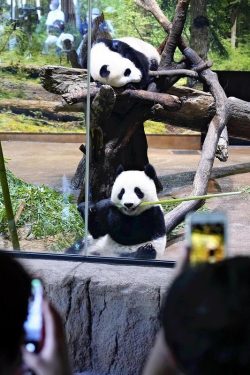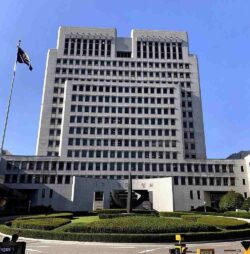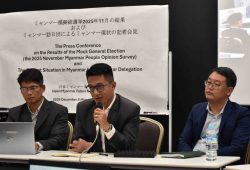13:30 JST, September 30, 2023
South Korea’s top three battery makers are highly likely to see a surge in both sales and operating profits despite their reduced market share in the global electric vehicle battery market, which is dominated by Chinese rivals, according to market tracker SNE Research on Sept. 14.
“Due to China-made low-priced lithium iron phosphate (LFP) batteries, LG Energy Solution, Samsung SDI and SK On’s combined market share worldwide dropped from 30.4% in 2021 to 23.8% in the first half of this year,” said SNE Research CEO Kim Kwang-ju during the Advanced Battery Conference 2023 hosted by the firm in Seoul.
But Kim stressed that the three companies’ sales revenue skyrocketed 70.1% to $26.7 billion in the cited period.
The CEO projected that the operating profit margin for LG Energy Solution and Samsung SDI will range from 5% to 7% while SK On, the latecomer, is expected to turn a profit next year.
He also said that the Korean battery makers’ widening gap with the world’s No. 1 battery maker, CATL of China, is also likely to be reduced in the near future.
By 2025, CATL’s revenue is expected to stand at about $25 billion won, which is equivalent to those of the three Korean rivals combined.
While CATL’s operating margin rate will remain at around 20%, both LG and Samsung are estimated to elevate their margin rate to some 10%. During the same period, SK On’s margin rate is also expected to reach 5%.
The CEO, in particular, put emphasis on the Korean battery makers’ expansion in North America and Europe — key EV markets — through extensive partnerships with local carmakers.
“The market share of the three battery makers will exceed 50% in the long run,” Kim said. “Challenging China’s pricing war, Korean battery makers can hold their ground with their marketing strategies due to high-quality products with better profitability.”
Kim added that if the companies take advantage of the Inflation Reduction Act in the United States and Europe’s Critical Raw Materials Act, which effectively block China’s market penetration, the Korean trio is likely to improve profitability while expanding their market share globally.
After 2024, the three battery makers are expected to expand their businesses from nickel, manganese and cobalt (NCM) batteries to LFP batteries, Kim noted.
Regarding the rising demand for cylindrical 4680 battery cells — 46 millimeters in diameter and 80 millimeters in length — prompted by Tesla, Kim said Korea has the upper hand over China in the business, which should play a vital role in enhancing the companies’ presence in overseas markets.
In the first half of this year, China’s CATL and BYD boasted a combined market share of 52.5%. Even outside of their home market, their market share stood at a whopping 32.9%.
Their creeping presence comes as Chinese automakers including Geely, which owns global car brands like Volvo and Polestar, SAIC Motor and BYD are seeing a surge in sales in Europe and Asia, following success at home due to the Chinese government’s EV tax credit policy, according to SNE Research. The market share of China-based carmakers increased to 11.8% during the January-June period compared to 9.5% last year.
The Korean top three on the same day unveiled business strategies for cost-effective EV batteries, challenging the Chinese rivals’ cheap LFPs. The companies had focused on producing NCM batteries for medium-priced or high-end electric cars.
“The company is developing a high-voltage mid-nickel NCM battery that is affordable, safe and provides a sufficient driving range,” said Choi Seung-don, head of advanced automotive battery development center at LG Energy Solution, during the conference. “We believe it will have a higher energy density than rival products.”
Choi highlighted that although LFP batteries might be slightly cheaper, they are 30% heavier and take up more space in the car than the mid-nickel NCMs. EVs installed with LFPs have a shorter driving range, he said, adding that the batteries are difficult to recycle, unlike NCMs that can be reused and recycled.
Acknowledging it is too late to join the race to roll out LFPs, Samsung SDI vowed to produce LMFP batteries, a mixed product of LFP and lithium manganese phosphate. It also plans to make NMX, a type of cobalt-free battery that consists of nickel and manganese.
“NMX and LMFP batteries inevitably have lower energy density than our premium products (like high-NCM batteries),” said Go Joo-young, executive vice president and head of strategic marketing at Samsung SDI. “The two should have high level of energy per battery cell in order to gain competitive edge in the market.”
SK On, the one and only Korean battery maker who announced it would produce LFP batteries, said it will add two more lineups to its low-priced product portfolio of less-cobalt and cobalt-free batteries.
"World" POPULAR ARTICLE
-

8 Japanese Nationals Stranded on Indonesia’s Sumatra Island
-

Mozambican Cooking Class Held in Matsuyama, Ehime Pref.; Participants Don Aprons, Bandanas Made from Traditional Mozambique Fabric
-

China to Impose Sanctions on Shigeru Iwasaki, Former Head of Japan’s Self-Defense Forces, Who Serves as Adviser to Taiwan’s Executive Branch
-

China Steps Up ‘Wolf Warrior’ Diplomacy Against Japan, Hurling Accusation About Plutonium Stockpile
-

U.S. Senate Resolution Backs Japan, Condemns China’s Pressure
JN ACCESS RANKING
-

Keidanren Chairman Yoshinobu Tsutsui Visits Kashiwazaki-Kariwa Nuclear Power Plant; Inspects New Emergency Safety System
-

Imports of Rare Earths from China Facing Delays, May Be Caused by Deterioration of Japan-China Relations
-

University of Tokyo Professor Discusses Japanese Economic Security in Interview Ahead of Forum
-

Japan Pulls out of Vietnam Nuclear Project, Complicating Hanoi’s Power Plans
-

Govt Aims to Expand NISA Program Lineup, Abolish Age Restriction






















